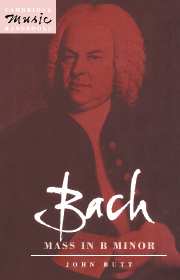Book contents
- Frontmatter
- Contents
- Preface
- List of abbreviations
- 1 The musical genre of the mass Ordinary
- 2 Genesis and purpose
- 3 Reception history
- 4 Text and music: the process of adaptation and composition
- 5 Ritornello forms
- 6 The influence of the dance
- 7 Counterpoint
- 8 Figurae and the motivic texture
- 9 Patterns and proportions: large-scale structuring and continuity in the Mass in B Minor
- Afterword
- Notes
- Select bibliography
- Index
4 - Text and music: the process of adaptation and composition
Published online by Cambridge University Press: 05 June 2012
- Frontmatter
- Contents
- Preface
- List of abbreviations
- 1 The musical genre of the mass Ordinary
- 2 Genesis and purpose
- 3 Reception history
- 4 Text and music: the process of adaptation and composition
- 5 Ritornello forms
- 6 The influence of the dance
- 7 Counterpoint
- 8 Figurae and the motivic texture
- 9 Patterns and proportions: large-scale structuring and continuity in the Mass in B Minor
- Afterword
- Notes
- Select bibliography
- Index
Summary
When Bach began to compile the four manuscripts constituting the Mass in B Minor much of the material already existed. For not only was the text in a complete and unalterable form – not always the case in a texted composition – but much of the music was to be adapted from cantatas which had already been performed. Thus an introduction to the work itself should perhaps begin not only with a presentation of the text but also with an account of the origins of the music. In attempting to recreate the situation and understand the decisions Bach made, we may gain some insight into the extraordinary processes by which this composer structured music of diverse origins into a coherent whole. In some ways this parallels his activity as a composer per se: he drew from all the musical styles of his time, its forms, generative structures and figuration. What is remarkable is Bach's manipulation, rather than creation, of musical language.
Only with a musical aesthetic later than Bach's does the concept of parody (adapting existing vocal music to a new text) appear in an unfavourable light. As music became more an autonomous art and less an established craft within certain social structures, the composer strove to find an individual voice; genius and originality were virtually synonymous concepts. In Bach's time, however, a certain degree of parody was almost unavoidable, since music had to be provided so regularly for specific occasions in church, court and theatre.
- Type
- Chapter
- Information
- Bach: Mass in B Minor , pp. 42 - 59Publisher: Cambridge University PressPrint publication year: 1991

